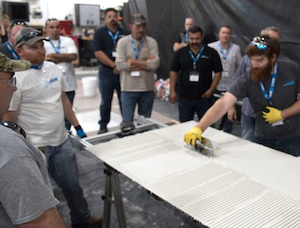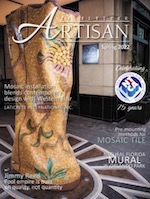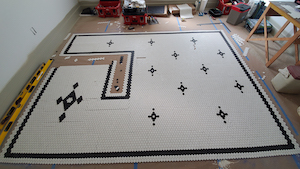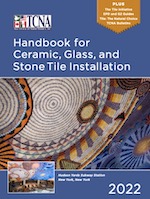This month – the 28th of July, as a matter of fact – The National Tile Contractors Association (NTCA) celebrates its 75th Anniversary!
NTCA is publishing a special coffee table book coming out this summer to commemorate this milestone.
But as we crafted this commemorative volume, some responses about the major changes the industry has experienced in the last 75 years and what we need to focus on in the future emerged. We’d like to share them here to give you an overview of the industry that has given birth to NTCA and what challenges are on the horizon.
We asked industry leaders about the biggest step the industry has taken in the last 75 years. And we received a range of answers – as you might expect – from tile size to the emergence of the thinset tile setting method, to the cachet tile installers hold in the industry. Let’s take a deeper dive into these answers.
Thinset method






Rod Owen of C.C. Owen Tile named the broad adaptation of the thinset method as a huge change that allowed “tile to become more competitive with other finishes, with less installation time – all contributing to the increase of tile being sold. Elizabeth Lambert, Lambert Tile & Stone, said the evolution of mortar and grout technology “and the introduction of recycled content is a step in the right direction. Technology will continue to move us forward and we need to continue standardizing methods in order to help reduce failures. Tile installed correctly should last a lifetime!” Eric Astrachan, Tile Council of North America (TCNA), placed the significance of thinset “up there along with the invention of cement board. And I believe the introduction of ceramic panels and slabs is the next great evolution.”
Tile sizes




Indeed, tile size was named as another revolutionary development. Scott Maslowski of Dal-Tile LLC cited the “size and complexity” of tile choices being installed – from 1″x1″ mosaics to 5’x10′ panels – which “have challenged all of us to adapt to new industry standards to keep pace with an ever-changing market.” J&R Tile’s Erin Albrecht called out gauged porcelain tile as well, noting that her company has “taken the steps in education and training to successfully install these products, and will be prepared with our Certified Tile Installers (CTIs) and Advanced Certifications for Tile Installers (ACT)s as more come to fruition in design specifications.”



Paige Smith, Neuse Tile Service, has observed labor change from being the “inexpensive element in an installation to… the more expensive key to a tile project. The skill and artistry needed to install the myriad of products today is better respected and more challenging to find in today’s world. As products have evolved to make installation ‘easier,’ it takes a team with the technical knowledge to know which product to use, the installation skills to know what approach to take, and the experience to convey realistic expectations to end users.”
Working together




Some industry leaders feel relationships have built a bridge to greater progress. The Ceramic Tile Distributor Association’s (CTDA) Rick Church said, “The evolution CTDA most values is the continued evolution in the working relationship between CTDA and NTCA. Together, we continue to find ways to make the industry better and improve the relationships between distributors and contractors.” And D&B Tile’s Harold Yarborough finds value in “joining together with other industry associations to put out the ‘WHY TILE’ message out to the public.”


Gianna Vallefuoco, of Vallefuoco Contractors LLC, offered a novel view of evolutionary changes in the last few years, especially since the pandemic.


“During the lockdown, the industry, especially NTCA, embraced the importance of wellness practices, adding mindfulness and compassion as tile industry priorities. We witnessed people grow closer and kinder. Tile installation has become a true art form with endless products and cutting edge tools. We see abundant ways to install and create mosaics, many made by hand by our industry artisans. There’s even a tile publication that emerged called TileLetter ARTISAN, acknowledging the importance of a set of skilled and passionate human hands.




“The TCNA Handbook has grown proportionately to the size of our large-format tiles,” she added. “The NTCA Technical Committee has grown along with the massive number of new tile products. The NTCA Consumer Education Committee was formed to combat the misinformation on the web, and to help consumers hire skilled tradespeople. The tile industry has long been a haven of diversity with skilled immigrants from across the globe. There are now more women in leadership roles and working as skilled tradespeople. I do hope to see more BIPOC (Black, Indigenous, and People of Color) representation in the future. As long as we stay curious and focused on the wellness of ourselves and our planet, we will continue to evolve as an industry of creatives and artisans.”
Moving ahead


What’s key in the future, according to Custom Building Products’ Will White, is “maintaining awareness, continuing education efforts, renewing interest in the trades and most importantly working together as an industry.”
Recruiting and training tile professional installers – including bringing young people into the fold – is essential for the industry to thrive going forward. “We will need to ensure that education is available regarding new, improved installation methods so that seasoned tile installers can expand their installation capabilities, margins, and keep pace with innovations in tile,” said Dal-Tile’s Maslowski. “Everyone involved with NTCA has an obligation to help expand and educate the labor base to ensure that we achieve the strongest overall industry possible.”




Industry legend and consultant Dave Gobis doesn’t mince words about what needs to happen in the future. “If we don’t grab hold and correct the declining skill levels of tile setters, we are going to be part of a low-growth stagnant industry. I increasingly hear from clients we can’t take the risk of a costly tile installation failure – and they are rampant.”
D&B’s Yarborough said, it’s necessary to find funds to hire staff to “engage more with the builders, architects, design firms and developers, educating them on the value of certified, trained installers and why proper methods of installation are the key to their building projects. This can be accomplished in the way that NTCA joins with other associations, supporting the CTEF and the Coverings show. Manufacturers need to dedicate 1% of all their tile sales to supporting the message to the professionals like builders, architects, design firms and developers.”
Neuse Tile Service’s Smith feels it’s necessary to build on past experience to grow in the future, which she sees “typified with the new-found interest in ‘mud’ work. Our company’s installers have always been skilled in mud work while adapting to other innovations as they were introduced. The key is that they see it as adding another tool to their repertoire, thus expanding their knowledge and ability to adapt to the unique circumstances of each installation. If we teach with this perspective and build on the skill and talent of past methods as we incorporate new innovations, then we have the opportunity to bring mastery and craftsmanship to another generation of true artisans…Elevating the respect for talent and independent business concerns is the only way to keep the industry moving forward.”


Schluter’s Dale Kempster sounded an encouraging note, calling on NTCA’s resources to attract youth and shine a light on the advantages offered by trades
“The future looks very good for the NTCA, even with the economic issues we face with inflation, limitations on raw materials, lack of labor force,” he said. “This is the time for NTCA to really to put itself out there and draw the youth – and those who want a career change – to our industry… Low-paying white collar jobs and the high cost for education for loans/debt now make the trades more enticing than ever. Plus, in what other trade do you get to start a project from the bottom up to completion, which gives a real sense of pride and
accomplishment?!”
Editorial Director and Senior Writer for TileLetter and TileLetter ARTISAN
Lesley Goddin has been writing and journaling since her first diary at age 11. Her journey has taken her through a career in publishing and publicity, landing her the editor position of TileLetter and its special publications in 2006. Her goal is to educate, inspire, recognize and encourage those in the tile industry -- especially the tile and stone contractor.








